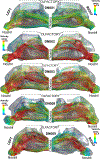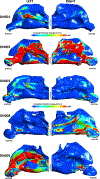Role of nasal vestibule morphological variations on olfactory airflow dynamics
- PMID: 33548767
- PMCID: PMC8294407
- DOI: 10.1016/j.clinbiomech.2021.105282
Role of nasal vestibule morphological variations on olfactory airflow dynamics
Abstract
Background: The conductive mechanisms of olfaction are typically given little priority in the evaluation of olfactory function. The objective of this study is to investigate the role of nasal vestibule morphological variations on airflow volume at the olfactory recess in healthy subjects.
Methods: Anatomically realistic three-dimensional nasal airway models were constructed from computed tomography scans in five subjects. Each individual's unilateral nasal cavity (10 total) was classified according to the shape of their nasal vestibule: Standard, Notched, or Elongated. Nasal airflow simulations were performed using computational fluid dynamics modeling at two inspiratory flow rates (15 L/min and 30 L/min) to reflect resting and moderate breathing rates. Olfactory airflow volume and cross-sectional flow resistance were computed.
Findings: Average olfactory airflow volumes (and percent airflow in olfactory) were: 0.25 L/min to 0.64 L/min (3.0%-7.7%; 15 L/min simulations) and 0.53 L/min to 1.30 L/min (3.2%-7.8%; 30 L/min simulations) for Standard; 0.13 L/min - 0.47 L/min (2.0%-6.8%; 15 L/min simulations) and 0.06 L/min - 0.82 L/min (1.7%-6.1%; 30 L/min simulations) for Notched; and 0.07 L/min - 0.39 L/min (1.2%-5.4%; 15 L/min simulations) and 0.30 L/min - 0.99 L/min (2.1%-6.7%; 30 L/min simulations) for Elongated. On average, relative difference in olfactory resistance between left and right sides was 141.5% for patients with different unilateral phenotypes and 82.2% for patients with identical unilateral phenotype.
Interpretation: Olfactory cleft airflow volume was highest in the Standard nasal vestibule phenotype, followed by Notched phenotype for 15 L/min simulations and Elongated phenotype for 30 L/min simulations. Further, intra-patient variation in olfactory cleft airflow resistance differs greatly for patients with different unilateral phenotypes compared to patients with identical unilateral phenotype.
Keywords: Airflow; Computational fluid dynamics; Nasal vestibule morphology; Olfactory airflow transport; Particle transport.
Copyright © 2021 Elsevier Ltd. All rights reserved.
Conflict of interest statement
CONFLICT OF INTEREST: No conflict of interest
Figures





Similar articles
-
Analyses on the influence of normal nasal morphological variations on odorant transport to the olfactory cleft.Inhal Toxicol. 2022;34(11-12):350-358. doi: 10.1080/08958378.2022.2115175. Epub 2022 Aug 31. Inhal Toxicol. 2022. PMID: 36045580 Free PMC article.
-
A computational analysis of nasal vestibule morphologic variabilities on nasal function.J Biomech. 2016 Feb 8;49(3):450-7. doi: 10.1016/j.jbiomech.2016.01.009. Epub 2016 Jan 19. J Biomech. 2016. PMID: 26830439
-
Impact of Intra-Phenotypic Nasal Vestibular Variation on Local Airflow Dynamics.Laryngoscope. 2025 Jan;135(1):50-58. doi: 10.1002/lary.31688. Epub 2024 Aug 21. Laryngoscope. 2025. PMID: 39166731
-
Impact of Middle Turbinectomy on Airflow to the Olfactory Cleft: A Computational Fluid Dynamics Study.Am J Rhinol Allergy. 2019 May;33(3):263-268. doi: 10.1177/1945892418816841. Epub 2018 Dec 13. Am J Rhinol Allergy. 2019. PMID: 30543120 Free PMC article.
-
The way the wind blows: implications of modeling nasal airflow.Curr Allergy Asthma Rep. 2007 May;7(2):117-25. doi: 10.1007/s11882-007-0009-z. Curr Allergy Asthma Rep. 2007. PMID: 17437682 Review.
Cited by
-
Correlation analysis of flow parameters in the olfactory cleft and olfactory function.Sci Rep. 2022 Dec 2;12(1):20819. doi: 10.1038/s41598-022-25282-3. Sci Rep. 2022. PMID: 36460767 Free PMC article.
-
Nasal anatomy and sniffing in respiration and olfaction of wild and domestic animals.Front Vet Sci. 2023 Jul 14;10:1172140. doi: 10.3389/fvets.2023.1172140. eCollection 2023. Front Vet Sci. 2023. PMID: 37520001 Free PMC article. Review.
-
The role of normal nasal morphological variations from race and gender differences on respiratory physiology.Respir Physiol Neurobiol. 2022 Mar;297:103823. doi: 10.1016/j.resp.2021.103823. Epub 2021 Dec 6. Respir Physiol Neurobiol. 2022. PMID: 34883314 Free PMC article.
-
Insights into exercise-induced rhinitis based on nasal aerodynamics induced by airway morphology.Respir Physiol Neurobiol. 2024 Jan;319:104171. doi: 10.1016/j.resp.2023.104171. Epub 2023 Oct 7. Respir Physiol Neurobiol. 2024. PMID: 37813324 Free PMC article.
-
Analyses on the influence of normal nasal morphological variations on odorant transport to the olfactory cleft.Inhal Toxicol. 2022;34(11-12):350-358. doi: 10.1080/08958378.2022.2115175. Epub 2022 Aug 31. Inhal Toxicol. 2022. PMID: 36045580 Free PMC article.
References
-
- Doty RL. Handbook of olfaction and gustation. John Wiley & Sons, 2015.
-
- Craven BA, Neuberger T, Paterson EG et al. Reconstruction and morphometric analysis of the nasal airway of the dog (Canis familiaris) and implications regarding olfactory airflow. Anatomical record (Hoboken, NJ : 2007) 2007; 290:1325–1340. - PubMed
-
- Eiting TP, Smith TD, Perot JB, Dumont ER. The role of the olfactory recess in olfactory airflow. J Exp Biol 2014; 217:1799–1803. - PubMed
-
- Zhao K, Scherer PW, Hajiloo SA, Dalton P. Effect of anatomy on human nasal air flow and odorant transport patterns: implications for olfaction. Chem Senses 2004; 29:365–379. - PubMed
Publication types
MeSH terms
Grants and funding
LinkOut - more resources
Full Text Sources
Other Literature Sources

